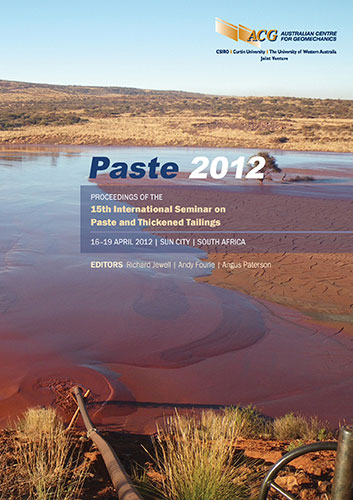RadFlow™ – the next generation feedwell

|
Authors: Krassnokutski, A |
DOI https://doi.org/10.36487/ACG_rep/1263_11_Krassnokutski
Cite As:
Krassnokutski, A 2012, 'RadFlow™ – the next generation feedwell', in R Jewell, AB Fourie & A Paterson (eds), Paste 2012: Proceedings of the 15th International Seminar on Paste and Thickened Tailings, Australian Centre for Geomechanics, Perth, pp. 121-127, https://doi.org/10.36487/ACG_rep/1263_11_Krassnokutski
Abstract:
Metallurgical thickeners have evolved over the past century in large technological leaps rather than through a slow and steady progression. The first of these technological leaps was the introduction of polymer flocculants in the 1950s which transformed large diameter conventional thickeners (with flux rates of 1‒2 t/m2/day and a rise rate of 1 m/h) into smaller diameter high rate thickeners (with flux rates of 2‒5 t/m2/day and a rise rate of 2–4 m/h) (Paterson & Cooke, 2010). The next leap was the development of more efficient closed feedwells in the 1980s which mixed the flocculant and feed more efficiently and distributed the feed into the thickener body more evenly. Lastly, was the development approximately 20 years ago, of so-called ‘auto-diluting’ systems in feedwells, which allowed feed dilution to take place internally (Triglavcanin, undated). There is still much room for improvement in thickener design and it is theoretically possible to design smaller, more stable thickeners operating at higher flux rates. In qualifying this statement, let us first consider how thickeners are sized – flocc settling rates are accurately determined with jar tests or dynamic desktop thickeners and multiplied with a safety factor of two or more to give a practical design rise rate. However, logic tells us that a rise rate, marginally smaller than the settling rate, will allow for all floccs to settle out of solution. So, where does this large safety factor stem from? This safety factor is the result of adverse flow effects within the thickener body which arise when changing from low aspect ratio desktop thickeners to high aspect ratio industrial thickeners. By running a myriad of experiments on a scale model thickener, adverse effects associated with standard industrial feedwells were determined. These adverse flow effects include tangential swirl, radial recirculation and flow asymmetry. To counter these effects, a series of feedwell models were constructed and tested in the scale model thickener; options included shelves, baffles and vanes in varying configurations and geometries. Ultimately, the RadFlow™ feedwell evolved which best countered these adverse effects so that flocculated feed is evenly and gently introduced to flow into the thickener body.
References:
Arbuthnot, I. (2008) Open vs Closed Thickener Feedwells – still a debating point?, viewed 22 February 2012, retrieved from , August 2008, 4 p.
Paterson & Cooke (2010) Slurry Dewatering and Thickener Operation, A Short Course, Johannesburg, pp. 9–10.
Triglavcanin, R.A. (undated) Thickener Technology – Smaller and Smarter, viewed 22 February 2012, retrieved from , 8 p.
© Copyright 2025, Australian Centre for Geomechanics (ACG), The University of Western Australia. All rights reserved.
View copyright/legal information
Please direct any queries or error reports to repository-acg@uwa.edu.au
View copyright/legal information
Please direct any queries or error reports to repository-acg@uwa.edu.au